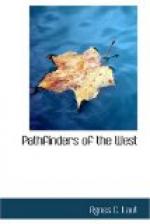[12] It will be noted that what I claim for Radisson is the honor of discovering the Great Northwest, and refrain from trying to identify his movements with the modern place names of certain states. I have done this intentionally—though it would have been easy to advance opinions about Green Bay, Fox River, and the Wisconsin, and so become involved in the childish quarrel that has split the western historical societies and obscured the main issue of Radisson’s feat. Needless to say, the world does not care whether Radisson went by way of the Menominee, or snow-shoed across country. The question is: Did he reach the Mississippi Valley before Marquette and Jolliet and La Salle? That question this chapter answers.
[13] I have refrained from quoting Radisson’s names for the different Indian tribes because it would only be “caviare to the general.” If Radisson’s manuscript be consulted it will be seen that the crucial point is the whereabouts of the Mascoutins—or people of the fire. Reference to the last part of Appendix E will show that these people extended far beyond the Wisconsin to the Missouri. It is ignorance of this fact that has created such bitter and childish controversy about the exact direction taken by Radisson west-north-west of the Mascoutins. The exact words of the document in the Marine Department are; “In the lower Missipy there are several other nations very numerous with whom we have no commerce who are trading yet with nobody. Above Missoury river which is in the Mississippi below the river Illinois, to the south, there are the Mascoutins, Nadoessioux (Sioux) with whom we trade and who are numerous.” Benjamin Sulte was one of the first to discover that the Mascoutins had been in Nebraska, though he does not attempt to trace this part of Radisson’s journey definitely.
[14] The entire account of the people on “the Forked River” is so exact an account of the Mandans that it might be a page from Catlin’s descriptions two centuries later. The long hair, the two crops a year, the tobacco, the soap-stone calumets, the stationary villages, the knowledge of the Spaniards, the warm climate—all point to a region far south of the Northern States, to which so many historians have stupidly and with almost wilful ignorance insisted on limiting Radisson’s travels. Parkman has been thoroughly honest in the matter. His La Salle had been written before the discovery of the Radisson Journals; but in subsequent editions he acknowledges in a footnote that Radisson had been to “the Forked River.” Other writers (with the exception of five) have been content to quote from Radisson’s enemies instead of going directly to his journals. Even Garneau slurs over Radisson’s explorations; but Garneau, too, wrote before the discovery of the Radisson papers. Abbe Tanguay, who is almost infallible on French-Canadian matters, slips up on Radisson, because his writings preceded the publication of the Radisson Relations.




